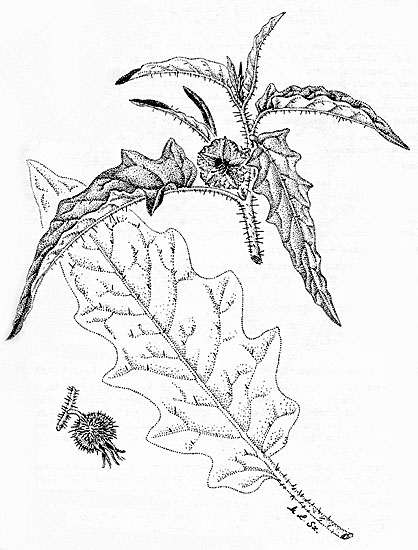
Synonymy
Solanum petraeum Symon, J. Adelaide Bot. Gard. 4: 294; figs 135, 137, 138 (1981)
T: Surveyors Pool, Mitchell Plateau, far NW Kimberley, 1 June 1971, D.E. Symon 7139; holo: PERTH; iso: AD ex ADW, CANB, K, L, NT.
Description
Spreading shrub to 1.5 m, male or female, grey-green to dark grey-green, densely pubescent with stellate hairs; prickles to 5 mm long, abundant on stems and calyx-tube.
Leaves lanceolate; lamina 3-7 cm long, 10-12 mm wide, slightly discolorous, entire; petiole to 10 mm long. Juvenile leaves up to 18 cm long, lobed; lobes broadly triangular or rounded; petiole to 3 cm long.
Male plant: inflorescence 10-14-flowered; peduncle c. 4 cm long; rachis to 8 cm long; pedicels 8-12 mm long; calyx 6-8 mm long, the lobes narrowly triangular to linear, 4-5 mm long; corolla broadly stellate, 15-25 mm diam., pale lavender; anthers 4-5 mm long. Female plant: flowers solitary; peduncle absent; pedicel to 12 mm long; calyx 10-11 mm long, the lobes linear, 5-6 mm long; corolla broadly stellate to rotate, 2-3 cm diam., lavender; anthers 4 mm long.
Berry depressed globular, 15-20 mm diam., pale, enclosed in enlarged calyx. Seeds 1.5 mm long, dark brownish. n=12.
Distribution and ecology
A poorly known species restricted to the far north-west of the Kimberley, W.A., occurring among or at the base of quartzite rock masses in monsoonal scrub and woodland.
Relationships
All of the dioecious members of the Dioicum group of subgen. Leptostemonum exhibit functional dioecy i.e. male flowers are borne on separate plants from what appear to be plants with bisexual or hermaphrodite flowers; while these bisexual flowers do produce pollen, it is inaperturate and does not germinate, making the flowers effectively female (Knapp et al.,1998).
Initial molecular studies by Martine et al. (2006) suggested that the two functionally dioecious species from Kakadu, S. asymmetriphyllum and the newly described S. sejunctum, formed a separate clade and had arisen separately from the other dioecious members of the Dioicum group, S. cunninghamii, S. cataphractum , S. dioicum, S. petraeum, S. carduiforme, S. tudununggae, S. vansittartense and S. leopoldense. This initial DNA analysis involved sequencing of the ITS region of nuclear rDNA.
However further molecular analysis involving the trnK-matK gene region indicated that all of the functionally dioecious species form a single clade arising from the andromononoecious species of the group (Martine et al., 2009).
Many of these dioecious species remain undercollected and poorly understood and it is likely that some of these names will be changed with further work. Three collections of S. petraeum were included in the initial ITS DNA analysis and these indicated a close relationship to each other and also to the single S. cataphractum collection. Likewise the second analysis indicted a close relationship between the two specimens included in the analysis.
References: S.Knapp, V.Persson & S.Blackmore (1998). Pollen morphology and functional dioecy in Solanum (Solanaceae). Pl. Syst. Evol. 210:113-139.; Martine, C.T., D. Vanderpool, G.J. Anderson, and D.H. Les (2006). Phylogenetic relationships of andromonoecious and dioecious Australian species of Solanum subgenus Leptostemonum section Melongena: Inferences from ITS sequence data. Systematic Botany 31: 410-420; Martine, C.T., G.J. Anderson & D.H. Les (2006). Gender-bending aubergines; molecular phylogenetics of cryptically dioecious Solanum in Australia. Australian Systematic Botany 22: 107-120.
Notes
Grades into S. dioicum
In the
Selected specimens
W.A.: Port Warrender, D.E. Symon 10221, 10222 (AD, PERTH).
Plant status, if any
This species has no conservation status in WA.
From the web
Further information can be found on the FloraBase site.
An account for this species is not yet available on the Solanaceae Source site.


